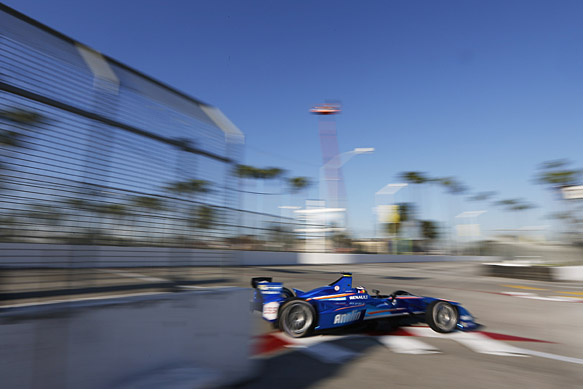Formula E cars will be “significantly” faster next season when the series is opened up to manufacturer development, says championship boss Alejandro Agag.
The FE technical package will be gradually opened up over coming years, starting with various areas of the powertrain in season two before new batteries are allowed in season three.
Agag said that the championship’s spec formula for its debut season was a deliberately cautious package.
“I don’t want to talk about how many seconds per lap, but the gains will be significant in season two,” Agag said when asked by AUTOSPORT about how much faster the cars will become.
“Already this season the teams have learned so much about how to manage a race and what they need to get more out of the cars.
“They are all working hard on how they can beat each other, and that competition is only going to get more serious when the manufacturers come in.
“For this season we had to produce 40 cars in a short space of time, so we had to be cautious with the performance. But this is just a starting point.”
Agag said that it would defeat the object of the series to maintain a spec formula beyond the first season.
“We are all racing people, and the teams are here to compete,” he said.
“That’s the great thing about competition, and that’s why we created this championship.
“Otherwise I don’t know why you do it. It’s about beating the others, and that’s what motivates everybody.”
DRIVERS: SPEED NOT A PROBLEM
Ex-Formula 1 driver Jean-Eric Vergne told AUTOSPORT that it does not matter to him that the first-generation Formula E cars are slower than most other major single-seaters.
“Even if it’s not quick, it’s still extremely difficult to drive,” he said.
“There’s not much grip, and the cars are heavy. It’s a lot more difficult to maximise than some other cars.
“You talk to the other drivers and they say it is harder to be quick in this car than an F1 car.
“In an F1 car, you know when a corner can be taken flat-out and you can trust the grip.
“Here you cannot trust anything. The car is moving around a lot more, and it doesn’t feel easy.”
DTM racer Antonio Felix da Costa believes that adding bottom-end power to the cars is more important than top speeds, even though the cars do not reach 200km/h in race trim at the moment.
“It would be nice to have more power when you first press the pedal,” he told AUTOSPORT.
“At the moment you just hit the accelerator coming out of every corner and it’s fine, no wheelspin, no trouble.
“So it could be more challenging in that respect. But top speed is not so important.
“It already feels faster than it is because you don’t have the engine sound, and I think on these tight street circuits we race on you could have some big accidents if the top speeds are too high.”






